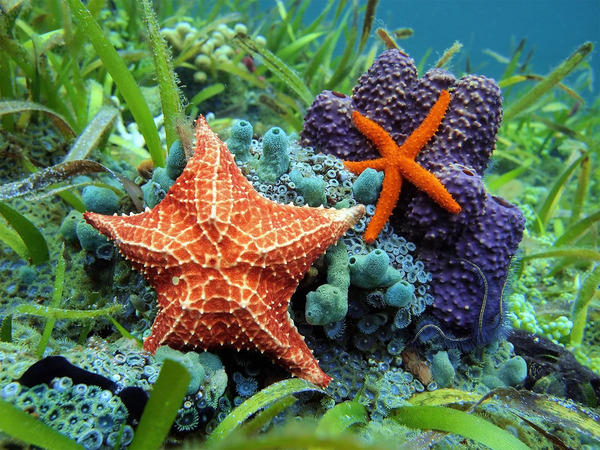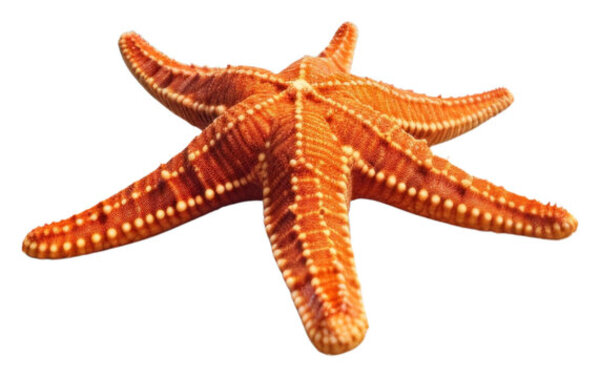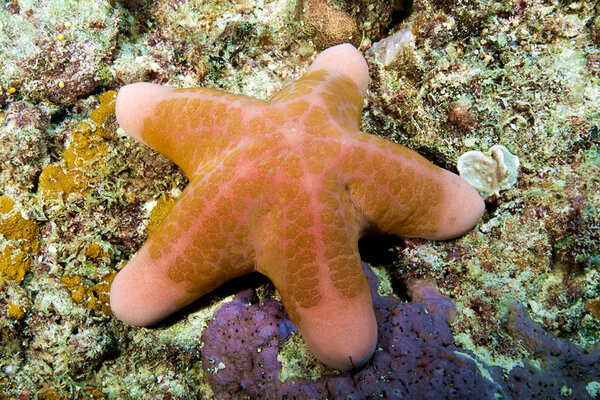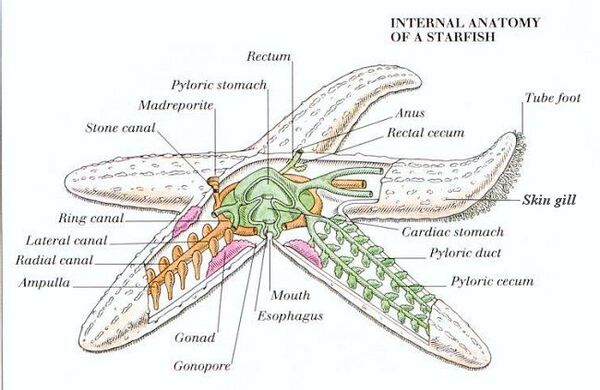Starfish, or sea stars, are captivating marine creatures belonging to the phylum Echinodermata, which also includes sea urchins, aquarium/sea-cucumbers.html">sea cucumbers, and brittle stars. Known for their star-shaped bodies and vibrant colors, starfish are among the most recognizable aquarium/52-marine-animals.html">marine animals. This article dives into the unique phylum to which starfish belong, exploring their fascinating anatomy, habitat, and ecological role. If you’re interested in marine life or curious about how starfish contribute to ocean ecosystems, keep reading!

Starfish are classified in the phylum Echinodermata. The name “echinoderm” comes from Greek, meaning “spiny skin,” which is a common trait in many species within this phylum. Echinoderms are unique to marine environments and are especially known for their radial symmetry—a body structure organized around a central axis. While starfish are perhaps the best-known members of Echinodermata, this phylum also includes:
Sea Urchins - Known for their spiky exteriors.
Sea Cucumbers - Soft-bodied with leathery skin.
Brittle Stars - Resembling starfish, but with thin, flexible arms.
Sand Dollars - Flat, circular echinoderms found in sandy areas.
1. Radial Symmetry
Unlike most animals with bilateral symmetry, starfish exhibit radial symmetry. Most have five arms, though some species can have as many as 50! This symmetry aids in their movement and feeding strategies.
2. Tube Feet
Starfish have hundreds of tiny tube feet on their undersides. These tube feet help them move slowly across the ocean floor and grab prey like shellfish. The tube feet work by hydraulic pressure, allowing the starfish to apply a surprising amount of force.
3. Regenerative Abilities
One of the most amazing abilities of starfish is their power to regenerate lost limbs. If a starfish loses an arm due to injury or predation, it can often regrow that arm over time. In some cases, a single arm can even regenerate a whole new starfish!
4. Lack of a Central Brain
Starfish don’t have a centralized brain like many animals. Instead, their nervous system is spread through a nerve ring around their mouth and down each arm. This decentralized system allows them to sense their surroundings and react without needing a brain.
5. Spiny Skin
True to their phylum’s name, starfish have spiny skin made of calcium carbonate, which serves as protection. The rough texture deters predators and helps them blend into rocky environments.

Starfish are found in oceans around the world, from shallow reefs to the deep sea. They thrive in a variety of habitats, including coral reefs, tidal pools, seagrass beds, and rocky shores. Most species prefer saltwater and are rarely found in freshwater environments.
Popular Starfish Species Include:
Crown-of-Thorns Starfish (Acanthaster planci): Known for its thorny appearance, it plays a controversial role in reef ecosystems by feeding on coral.
Sunflower Sea Star (Pycnopodia helianthoides): One of the largest starfish, found on the West Coast of North America.
Chocolate Chip Sea Star (Protoreaster nodosus): Named for the dark, knobby protrusions on its body.
Starfish are generally carnivorous and feed on a variety of aquarium/52-marine-animals.html">marine animals, such as mollusks (like clams and mussels), small fish, and coral polyps. Their tube feet allow them to pry open shells, and they can even extend their stomachs outside of their bodies to digest prey!
Starfish play an important role in marine ecosystems. By preying on certain species, they help maintain the balance of ocean life. For example, species like the Crown-of-Thorns Starfish can control coral growth, although an overpopulation can damage reefs. Starfish also serve as prey for larger marine animals, including fish and sea birds, thus contributing to the marine food web.
Water Vascular System: Echinoderms have a unique water vascular system, which powers their tube feet and enables movement.
Calcium Carbonate Endoskeleton: Their spiny skin is supported by an endoskeleton made of calcium carbonate plates, offering protection and structural support.
Marine-Exclusive: Unlike many other animal phyla, all echinoderms, including starfish, are exclusively found in marine environments.
| Feature | Description |
|---|---|
| Phylum | Echinodermata |
| Body Symmetry | Radial, often with five arms but can vary |
| Habitat | Marine environments worldwide, from shallow reefs to deep sea |
| Diet | Carnivorous, feeding on mollusks, small fish, and coral |
| Special Abilities | Arm regeneration, decentralized nervous system, hydraulic tube feet |
| Examples | Crown-of-Thorns Starfish, Sunflower Sea Star, Chocolate Chip Sea Star |
Starfish, as members of the phylum Echinodermata, are some of the ocean’s most remarkable creatures. Their unique physiology, fascinating feeding habits, and ecological significance make them an essential part of marine biodiversity. Whether admired for their beauty or studied for their unique abilities, starfish contribute to the health and balance of marine ecosystems. Understanding these unique animals helps us appreciate the diversity and complexity of life in our oceans.

The seven levels of classification for a starfish (using the common sea star, Asterias rubens, as an example) are part of the taxonomic hierarchy, which organizes all living organisms based on shared characteristics. This system, developed by Carl Linnaeus, provides a structured way to categorize and identify species. Here’s how a starfish is classified:
Kingdom: Animalia
Starfish belong to the kingdom Animalia, which includes all multicellular, eukaryotic organisms that are generally motile, respond to their environment, and consume organic material.
Phylum: Echinodermata
This phylum includes animals with "spiny skin" and a unique water vascular system. Other members of Echinodermata include sea urchins, sea cucumbers, and brittle stars, all of which share radial symmetry and are exclusively marine.
Class: Asteroidea
The class Asteroidea encompasses all sea stars or "starfish." Members of this class typically have a central disc and radiating arms. They exhibit the characteristic star shape that most people associate with starfish.

Order: Forcipulatida
This order includes starfish with tube feet that end in pincers or forceps-like structures, which help them grasp and handle prey or substrate. Many species in this order are found in cold and temperate seas.
Family: Asteriidae
The family Asteriidae contains sea stars with typically five arms (though some can have more) and a robust body structure. These sea stars are commonly found in various marine environments around the world.
Genus: Asterias
The genus Asterias includes several species of sea stars that are widespread in coastal waters. They are often used in scientific research because they are relatively easy to study and are common in many habitats.
Species: Asterias rubens
This specific species, Asterias rubens, is commonly known as the common sea star. It is often found in the North Atlantic and along European coastlines. Asterias rubens has five arms and is usually orange or red in color.
| Level | Classification | Description |
|---|---|---|
| Kingdom | Animalia | Multicellular animals with complex cells |
| Phylum | Echinodermata | Marine animals with radial symmetry and spiny skin |
| Class | Asteroidea | All star-shaped sea stars or "starfish" |
| Order | Forcipulatida | Sea stars with pincer-like tube feet |
| Family | Asteriidae | Strong-bodied sea stars with typically five arms |
| Genus | Asterias | Common genus of sea stars, well-researched in biology |
| Species | Asterias rubens | Common sea star found in the North Atlantic and Europe |
These classification levels help scientists understand relationships between species, trace evolutionary traits, and organize biodiversity more effectively.
The sea star, commonly known as the starfish, is classified under the phylum Echinodermata, which translates to "spiny skin" in Greek. The name Echinodermata is fitting for sea stars due to several key characteristics they share with other echinoderms, including sea urchins, sea cucumbers, and brittle stars. Here's why sea stars are called echinoderms:
Spiny Skin and Endoskeleton: Echinoderms are known for their unique skin and internal structure. Sea stars, like other echinoderms, have a calcified endoskeleton beneath their skin. In many sea stars, this skeleton consists of calcium carbonate plates, which often produce spiny structures on the surface of the skin, giving them a rough, armored appearance. This spiny quality is a hallmark of the echinoderm phylum.
Radial Symmetry: Unlike many animals that have bilateral symmetry, echinoderms display radial symmetry, which means their body parts are arranged around a central axis. Sea stars typically exhibit five-part symmetry (pentamerism), with five arms extending from a central disc, though some species can have more arms. This radial symmetry is a defining feature of the phylum.

Water Vascular System: One of the most distinctive characteristics of echinoderms, including sea stars, is their water vascular system, a network of fluid-filled canals. This system operates their tube feet, small, flexible appendages that help sea stars move, feed, and cling to surfaces. The water vascular system is unique to echinoderms and sets them apart from other marine animals.
Marine Habitat: Echinoderms are exclusively marine organisms, meaning they are found only in ocean environments. Sea stars are adapted to various marine habitats, from shallow reefs to deep-sea beds, and their classification within Echinodermata reflects this oceanic lifestyle.
Regenerative Abilities: Echinoderms, including sea stars, are well-known for their ability to regenerate lost body parts. Sea stars, in particular, can regrow lost arms, and in some cases, even regenerate an entire body from a single arm. This regenerative trait is also a characteristic of echinoderms.
The sea star's classification in the phylum Echinodermata highlights its shared features with other echinoderms, such as spiny skin, radial symmetry, the water vascular system, and marine habitat specialization. These unique adaptations not only make echinoderms distinct but also emphasize why the sea star fits so well within this fascinating group of marine animals.
animal tags: sea-star
We created this article in conjunction with AI technology, then made sure it was fact-checked and edited by a Animals Top editor.